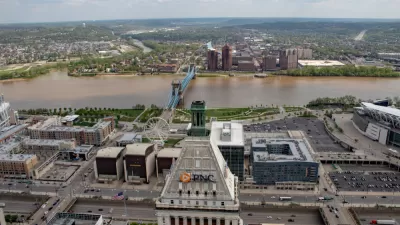Alan G. Brake celebrates the Queen City's utilization of public space, place making, and mixed-use development to build its competitive advantage, despite America's "deep-seated anti-urban streak."
Brake credits Mayor Mark Mallory with "making the case for Cincinnati's urbanity, for its cityness, as a competitive advantage, something that many small and midsized cities have long scorned," and for placing these items at the center of his mayoral agenda. Three interconnected projects reflect this ethos:
- A new mixed-use neighborhood in between the city's riverfront stadiums, along with a generous new waterfront park
- A coordinated redevelopment-including renovation and new construction-of a large piece of the Over the Rhine neighborhood
- A long-planned and hotly contested streetcar line connecting both areas with downtown in between
"In a recent video for Smart Growth America, the mayor articulated his
vision: 'We've got to be able to attract and retain young people, and
we've got to be able to attract and maintain the companies that are
going to create jobs. People are looking for public transportation when
they are deciding which city they want to be in. They are looking for
public infrastructure to be in place. All the elements you see in larger
cities that are stable, that have growing populations, we are trying to
incorporate into Cincinnati so we can level the playing field.'"
FULL STORY: Editorial> Getting It Right in the Queen City

Planetizen Federal Action Tracker
A weekly monitor of how Trump’s orders and actions are impacting planners and planning in America.

Map: Where Senate Republicans Want to Sell Your Public Lands
For public land advocates, the Senate Republicans’ proposal to sell millions of acres of public land in the West is “the biggest fight of their careers.”

Restaurant Patios Were a Pandemic Win — Why Were They so Hard to Keep?
Social distancing requirements and changes in travel patterns prompted cities to pilot new uses for street and sidewalk space. Then it got complicated.

Platform Pilsner: Vancouver Transit Agency Releases... a Beer?
TransLink will receive a portion of every sale of the four-pack.

Toronto Weighs Cheaper Transit, Parking Hikes for Major Events
Special event rates would take effect during large festivals, sports games and concerts to ‘discourage driving, manage congestion and free up space for transit.”

Berlin to Consider Car-Free Zone Larger Than Manhattan
The area bound by the 22-mile Ringbahn would still allow 12 uses of a private automobile per year per person, and several other exemptions.
Urban Design for Planners 1: Software Tools
This six-course series explores essential urban design concepts using open source software and equips planners with the tools they need to participate fully in the urban design process.
Planning for Universal Design
Learn the tools for implementing Universal Design in planning regulations.
Heyer Gruel & Associates PA
JM Goldson LLC
Custer County Colorado
City of Camden Redevelopment Agency
City of Astoria
Transportation Research & Education Center (TREC) at Portland State University
Camden Redevelopment Agency
City of Claremont
Municipality of Princeton (NJ)



























